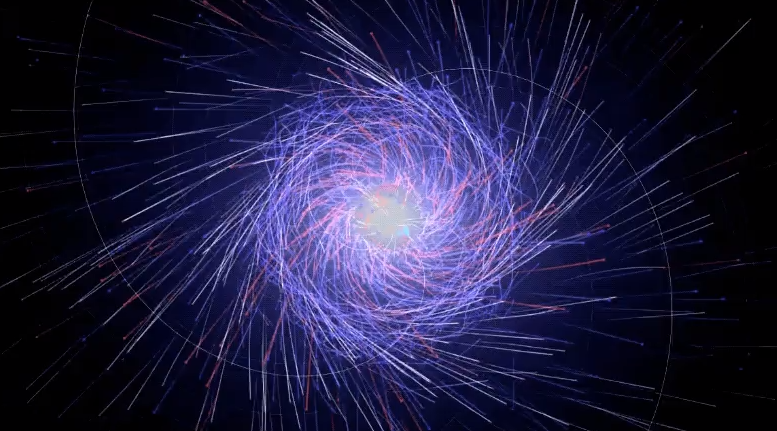
A new computer model is revealing the unseen and often bizarre behaviors of particles streaming around rapidly spinning neutron stars, also known as pulsars.
New research led by NASA astrophysicist Gabriele Brambilla shows the paths taken by charged particles caught in the magnetic and electric fields near pulsars. The work is based on a new way of modeling pulsars, and it’s offering an unprecedented glimpse into the inner workings of these exotic celestial formations.
Pulsars are the smushed remnants of massive stars that ran out of fuel, collapsed, and then exploded as a supernova. These whirling neutron stars pack a horrendous amount of mass into a small space; a typical pulsar is about the size of Manhattan, yet it contains more mass than the Sun. As they spin—often a thousand times per second—they exert the most powerful magnetic fields known to astrophysicists. At the same time, strong electrical fields tear away at particles on the neutron star’s surface, flinging them into space. From Earth, we can see a pulsar’s rotating beam of gamma rays and radio pulses at exquisitely regular intervals—an effect that’s often compared to the pulsating beam of lighthouse beacon.
Pulsars are like gigantic particle accelerator experiments floating in space, and they produce a lot freaky physics, both at the micro and macro scale. Astronomers have been studying pulsars for over 50 years, but they’re still not able to fully explain what they’re observing. Needless to say, we can’t create these extreme conditions on Earth, nor are we able to observe these objects from up close, the nearest of which is about 770 light-years from Earth. That’s why Brambilla and her colleagues turned to computer models to learn more about pulsars and how they affect the behavior of charged particles.
For the new study, published this week in the Astrophysical Journal, the scientists turned to a relatively new way of modeling pulsars— a simulation system known as PIC, or particle-in-cell.
“The PIC technique lets us explore the pulsar from first principles. We start with a spinning, magnetized pulsar, inject electrons and positrons at the surface, and track how they interact with the fields and where they go,” Constantinos Kalapotharakos, a co-author of the study and a scientist at NASA’s Goddard Space Flight Center, said in a statement. “The process is computationally intensive because the particle motions affect the electric and magnetic fields and the fields affect the particles, and everything is moving near the speed of light.”
The PIC simulation was performed on a pair of NASA supercomputers: the Discover supercomputer at NASA’s Center for Climate Simulation, and the Pleiades supercomputer at the Ames Research Center in California. Incredibly, the PIC model tracks the movement of each particle, which collectively represent trillions of electrons and their anti-matter counterparts, positrons.
The new computer simulation showed particle movements never considered before by scientists. For example, the researchers watched as most of the electrons traveled outward from the pulsar’s magnetic poles. Meanwhile, positrons flew out at lower altitudes, forming thin structures dubbed the “current sheet.”
A NASA press release explains some of the other observations made in the study:
Some of these particles likely become boosted to tremendous energies at points within the current sheet where the magnetic field undergoes reconnection, a process that converts stored magnetic energy into heat and particle acceleration.
One population of medium-energy electrons showed truly odd behavior, scattering every which way—even back toward the pulsar.
The particles move with the magnetic field, which sweeps back and extends outward as the pulsar spins. Their rotational speed rises with increasing distance, but this can only go on so long because matter can’t travel at the speed of light.
The distance where the plasma’s rotational velocity would reach light speed is a feature astronomers call the light cylinder, and it marks a region of abrupt change. As the electrons approach it, they suddenly slow down and many scatter wildly. Others can slip past the light cylinder and out into space.
If this sounds a bit cryptic, I highly recommend that you watch the visual simulation (shown in the video above) produced by NASA Goddard, which illustrates these processes rather nicely.
It’s easy to understand why physicists get so excited about pulsars, but astrobiologists and SETI scientists may find them valuable as well. Research published last year proposed that advanced aliens are more likely to build energy-collecting megastructures around pulsars than regular stars. The reason is that pulsars concentrate their energy in discrete beams, as opposed to scattering them in all directions, as most stars are wont to do.
Anyhoo, Brambilla are her colleagues are hoping to conduct further simulations of pulsars in order to gain a deeper understanding of their intense magnetospheres, and how pulsars might differ from one another.